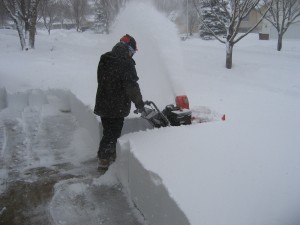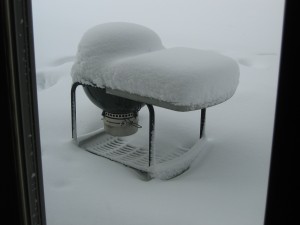
Depending on where you live, this might be right around the corner. Don’t you want a nice winter beer waiting for you when you’re done?
Now is a great time to brew this year’s winter warmer. Winter warmers (holiday beers, Christmas beers, etc.) span a lot of ground when it comes to their flavor and aroma. However, more often than not, they tend to be strong, dark, spiced ales. Because they are both strong and spiced, brew them a couple months in advance to give them the chance to age into their peak condition. before the holidays.
Covering every kind of special winter beer — or even the most common variants — would be impossible. So I’m going to stick to describing winter warmers of the strong, dark and spicy type because these are the most common (and also my favorite).
Strong
Most of these beers are big (6–8% ABV), but not titanically big. Using English pale ale malt (or a malt extract made from it) is a good choice for your base malt. You can accentuate the malty character of your winter warmer by adding some Munich or Vienna malt. These can be added at around 10% of the grist for Munich or 15% for Vienna for a subtle maltiness, or all the way up to 100% of the base malt for a more malty character.
When choosing the specialty malts, you have a variety of options. I like to think of it in terms of what the dominant specialty grain character is going to be. There are at least three options you can shoot for — roasty/chocolate-y, sweet/caramel-like or biscuit-y. And of course, these can be blended together. (See the end of the article for a table summarizing these possibilities.)
Dark, But Not Always Roasty
In a winter warmer, the dark grains can add either color or they can also add a roasty aroma and flavor to the beer. If you don’t want the beer to be particularly roasty, try adding some black malt (or roasted barley at around 500 °L). Only 4.0 oz. in a 5-gallon (19-L) batch is enough to move your beer into the brown part of the beer color spectrum, especially considering that more color that will be added by the other specialty malts. However, this is not enough to add significant roast flavor. If you use a recipe calculator that shows beer color, build your recipe starting with the other malts first, then slowly add in the black malt to hit the color you’re looking for.
If you do want some roast character, try adding chocolate malt. You can add chocolate malt starting at around 6.0 oz. (170 g) per 5.0 gallons (19 L) for a subtle chocolate note, and up to a little over a pound (0.50 kg) for a strongly roasty beer. Chocolate wheat and chocolate rye malts could also be used.
Caramel Sweetness
 Most winter warmers have a caramel sweetness to them and this can be the dominant malt character or it can accentuate either a roasty or biscuit-y beer. Crystal malt will add a caramel flavor to the beer as well as some color. The darker the malt, the more you get plum-like, raisin-like or scorched sugar notes. You can also add a blend of crystal or caramel malts, with some crystal malt in the 40 °L range for the classic caramel flavor, then add some darker crystal malts for added flavor and color. For example, a blend 10–12 oz. (280-340 g) of crystal malt (40 °L), roughly half a pound (230 g) of crystal malt (60 °L) and 4–6 oz. (110–170 g) of crystal malt (80 °L+) would yield a beer with a firm caramel/toffee taste and some raisin-like notes.
Most winter warmers have a caramel sweetness to them and this can be the dominant malt character or it can accentuate either a roasty or biscuit-y beer. Crystal malt will add a caramel flavor to the beer as well as some color. The darker the malt, the more you get plum-like, raisin-like or scorched sugar notes. You can also add a blend of crystal or caramel malts, with some crystal malt in the 40 °L range for the classic caramel flavor, then add some darker crystal malts for added flavor and color. For example, a blend 10–12 oz. (280-340 g) of crystal malt (40 °L), roughly half a pound (230 g) of crystal malt (60 °L) and 4–6 oz. (110–170 g) of crystal malt (80 °L+) would yield a beer with a firm caramel/toffee taste and some raisin-like notes.
A large amount of specialty malts, especially crystal malts, is going to yield a wort with fairly low fermentability. In a winter warmer, this is a good thing. You want some residual sweetness and body. You can further lower the fermentability by mashing at temperatures high in the saccharification range (154–162 °F/68–72 °C), but you don’t need to strive for the absolute lowest fermentability. Even if you normally brew all-grain, making an extract -based winter warmer can be a good idea because malt extract is usually lower in fermentability than worts made from grains.
Biscuit-Like Flavors
Biscuit-like notes, as found in some English ales, can be a nice character in a winter warmer. These are sometimes also described as being reminiscent of a cracker or lightly nutty. You can get this flavor by adding English or Belgian biscuit malt, American Victory malt or some other non-crystal malts (such as amber malt) kilned to around 25–35 °L.
In a 5.0-gallon (19-L) batch, you can add them from around 5.0 oz. (140 g) for a light biscuit note or up to 12–14 oz. (340–400 g) for a very biscuit-y beer. The distinct flavor of these malts blends well with crystal or caramel malts. Using between 8 and 12 oz. of crystal malt or a crystal malt blend will accentuate a biscuit or Victory malt focused beer well.
Hops
In a winter warmer, you need hops to balance the sweetness and body. But, you don’t want too much overt bitterness or flavor. (Once exception might be in a beer focused on the biscuit character and lightly spiced.) Most winter warmers are big, strongly flavored brews, so you don’t want to go too lightly on the bittering hops. One the other hand, the spices themselves may add some bitterness and you don’t want to add so much plant material as to yield a disagreeable amount of astringency. In most cases, adding 30–40 IBUs of bittering hops will put you in the right ballpark. Add late addition hops for flavor and aroma only in you’re sure they won’t conflict with the spices.
Yeast
In the type of winter warmer we are discussing, either a fruity, estery English ale yeast or a clean ale yeast strain will work. When choosing the yeast strain, think about if an ester-y fermentation profile is going to blend or clash with the spices you plan on adding. Some Belgian yeasts may also work well, although this is uncommon among commercial examples.
Because these are fairly big beers, always pitch an adequate amount of yeast so you can run a timely and ordered fermentation. If you pitch enough yeast, a 6–8% ABV spiced winter warmer should condition and be ready in 6 to 8 weeks.
Sometimes winter warmers age wonderfully, so be sure to squirrel away a couple bottles for next year. On the other hand, spiced beers can sometimes age very poorly, so don’t keep your hopes up too high. Be glad for the beers that do age well and don’t worry about those that don’t.
I’l discuss spicing in a separate article. The upshot will be to match your spices to your beer and don’t just empty the spice rack into your kettle.
Guidelines for Winter Warmer Base Beers
[for 5 gallons (19 L) of strong, dark, spiced ale]
Use these guidelines as a starting point for formulating the specialty grain portion of your 5-gallon (19-L) homebrew recipes. Round the recipe out with enough pale malt or malt extract, perhaps with some Munich thrown in, to reach an original gravity that will ferment out to 6–8% ABV. Do not let these recommendations stop you from trying something you think would turn out well. Use in conjunction with homebrew recipes and other sources to formulate the right brew for you.
Roasty Chocolate-y Winter Warmer Base
between 10 and 18 oz. (280 and 510 g) of chocolate malt or a blend of dark malts or grains with at least 50% chocolate malt(s)
between 6 and 16 oz. (170 and 450 g) of crystal malt or a crystal malt blend [keep darkest crystal malts (over 90 °L) under 4.0 oz. (110 g)]
under 5.0 oz. (140 g) of biscuit or similar malts [with 0 oz. (0 g) being a wonderful choice]
Caramel Sweet Winter Warmer Base
between 14 and 20 oz. (400 and 570 g) of crystal malt or a crystal malt blend [keep darkest crystal malts (over 90 °L) under 6.0 oz. (170 g)]
add up to 4.0 oz. (11 g) of black malt to adjust color or 6–10 oz. (170–280 g) of chocolate malt (or a dark malt blend) for a secondary roast character
under 5.0 oz. (140 g) of biscuit or similar malts [with 0 oz. (0 g) being a wonderful choice]
Biscuit-y English Winter Warmer Base
between 6.0 and 14 oz. (170 and 400 g) of English biscuit, Belgian biscuit or American Victory malt
between 4.0 and 14 oz. (110 and 400 g) of crystal malt or a crystal malt blend [keep darkest crystal malts (over 90 °L) under 5.0 oz. (140 g)]
add up to 4.0 oz. (110 g) of black malt to adjust color


My beers for winter are summer beers else where (Phoenix) . I can finally sit outside without burning up and brew anytime of the day. Some lawn mower brews to come.
I think 230 kg of crystal malt might make a beer slightly cloying.
Yikes! Conversion error. I’ll change that to 230 g.
My job here is done.
-Captain Know-It-All
Chris – Did you mean to leave out the biscuit recommendations for the Roasty Chocolate-y and the Caramel Sweet? Thanks for the inspiration for this winter!
In those beers, I would not add any biscuit malt. (Or, at most, add just enough to be barely detected.)
Is wheat acceptable for a portion of the grain bill? I’m thinking of Roasty Chocolate-y Winter Warmer Base, with 10-15% of the total bill wheat.
You can add anything you want to a winter warmer, really. But you certainly could use a percentage of wheat in the roasty base (or the other two). Weizenbocks are big, roasty wheat beers.